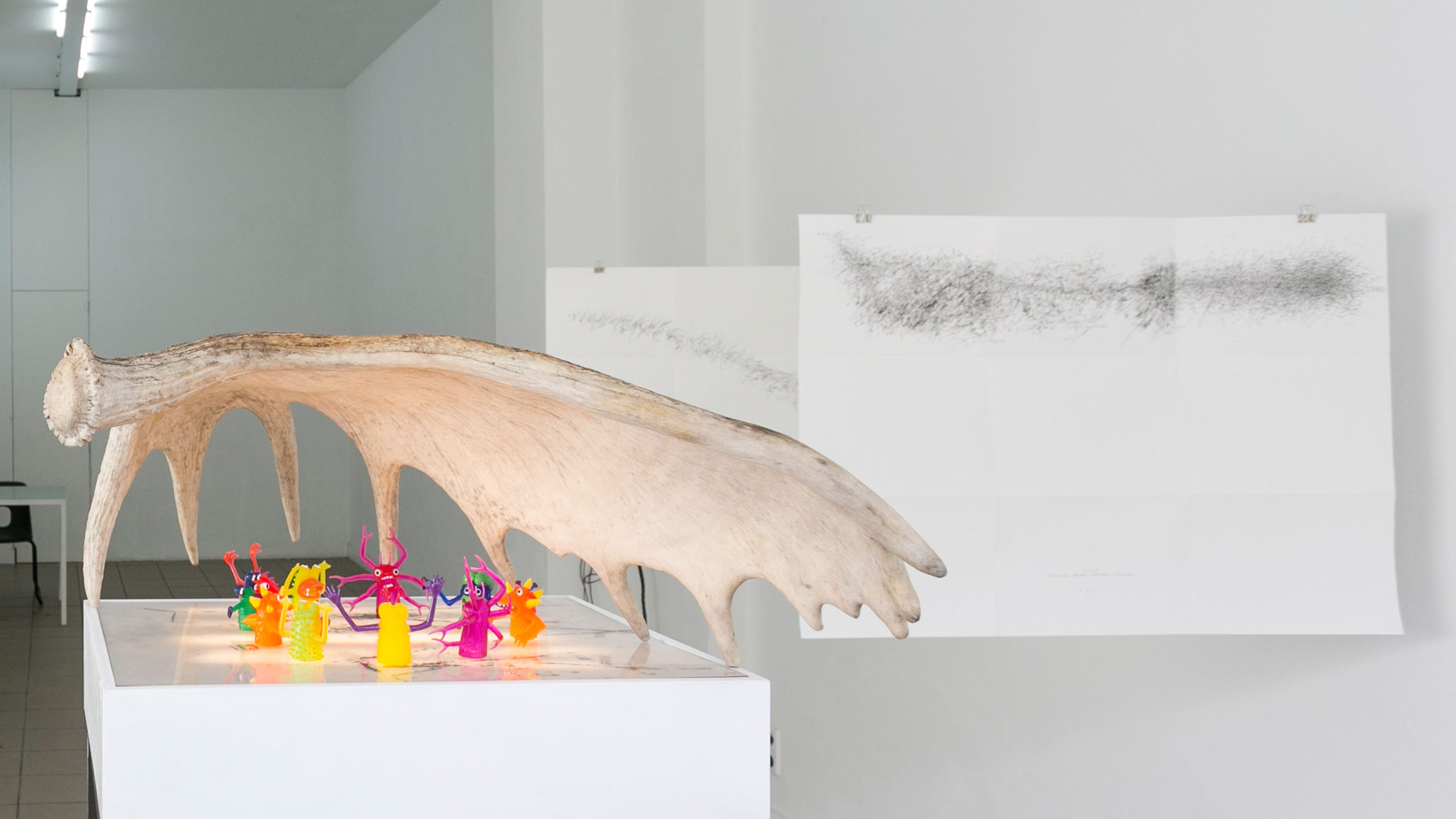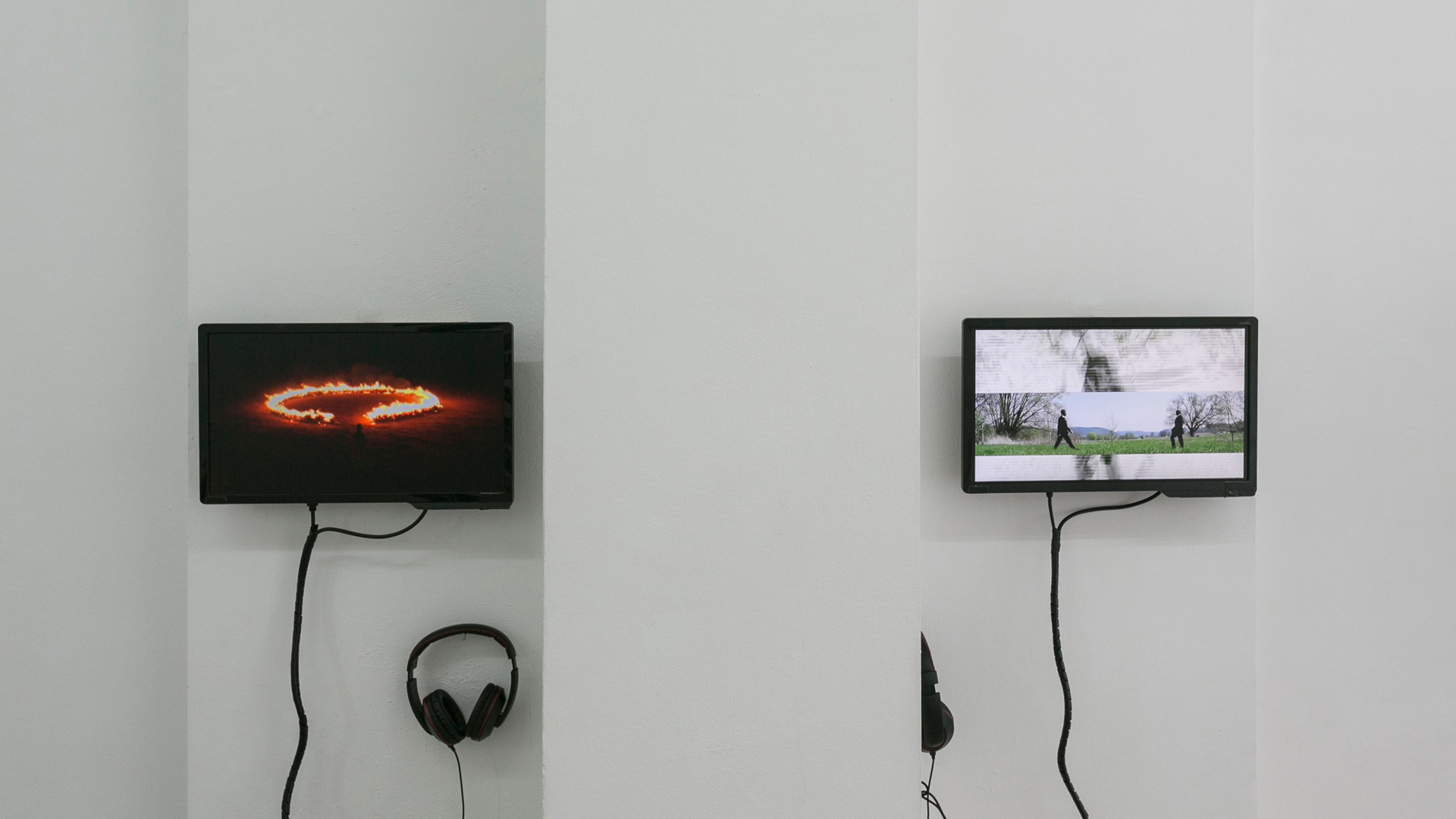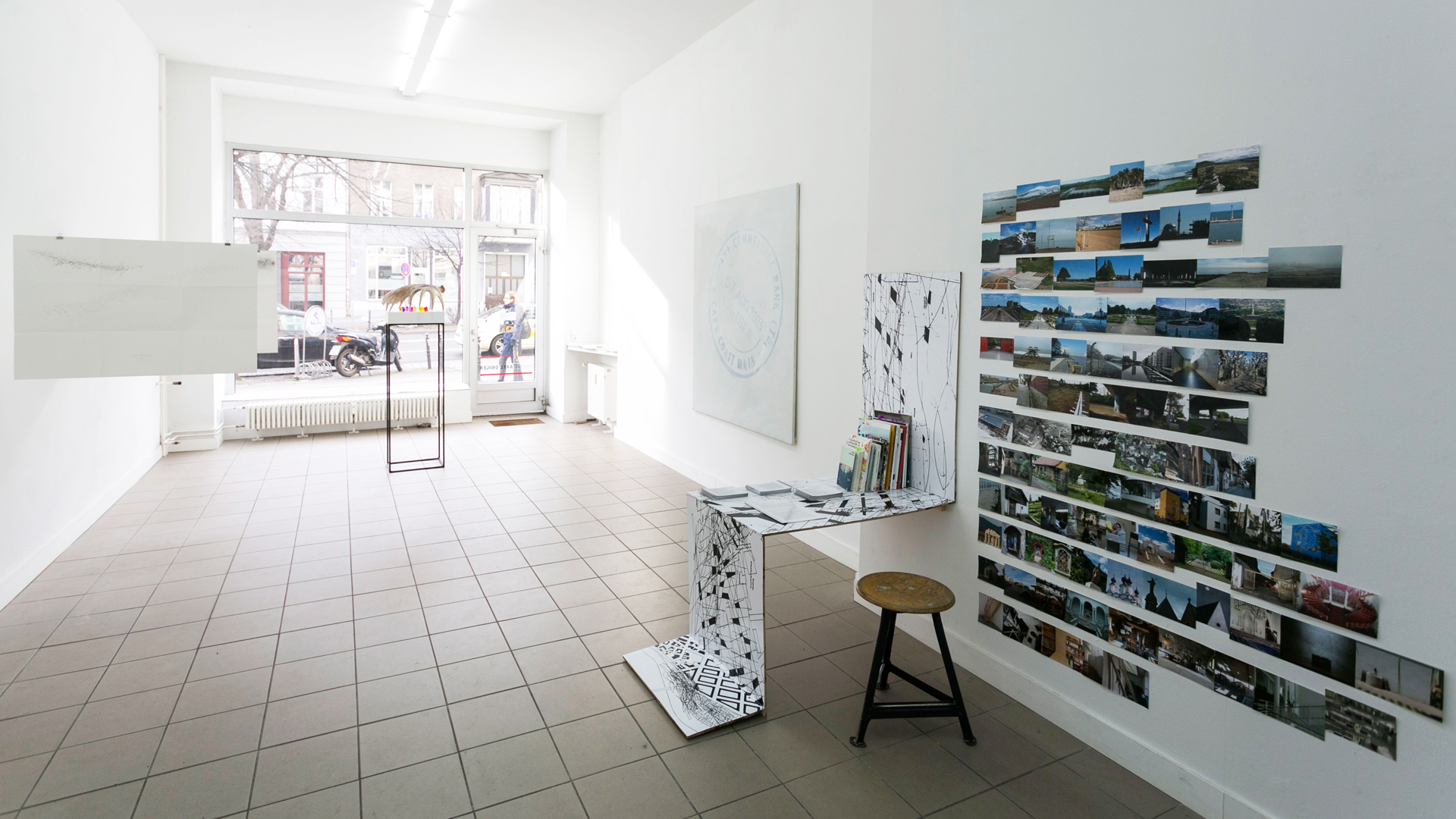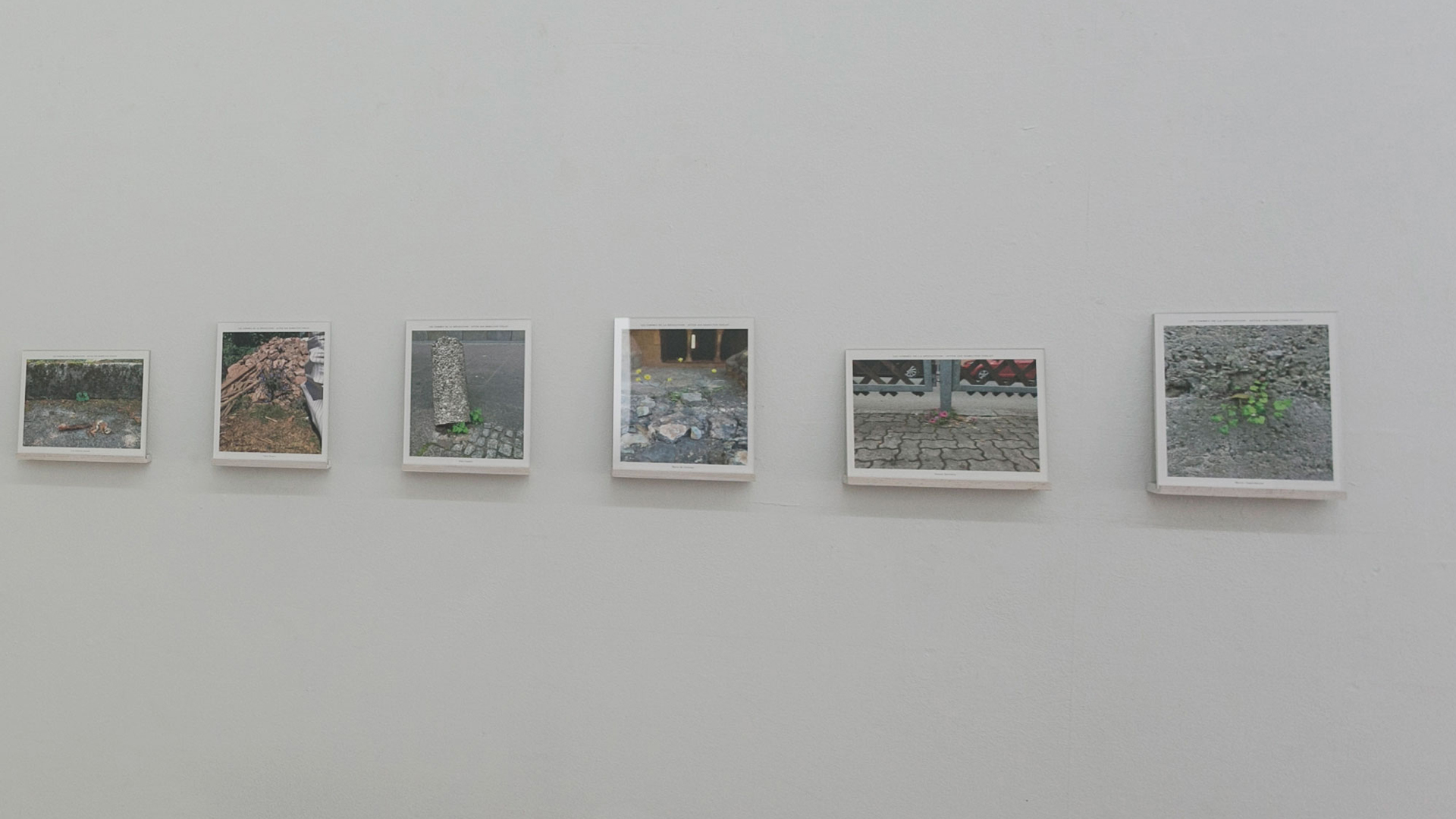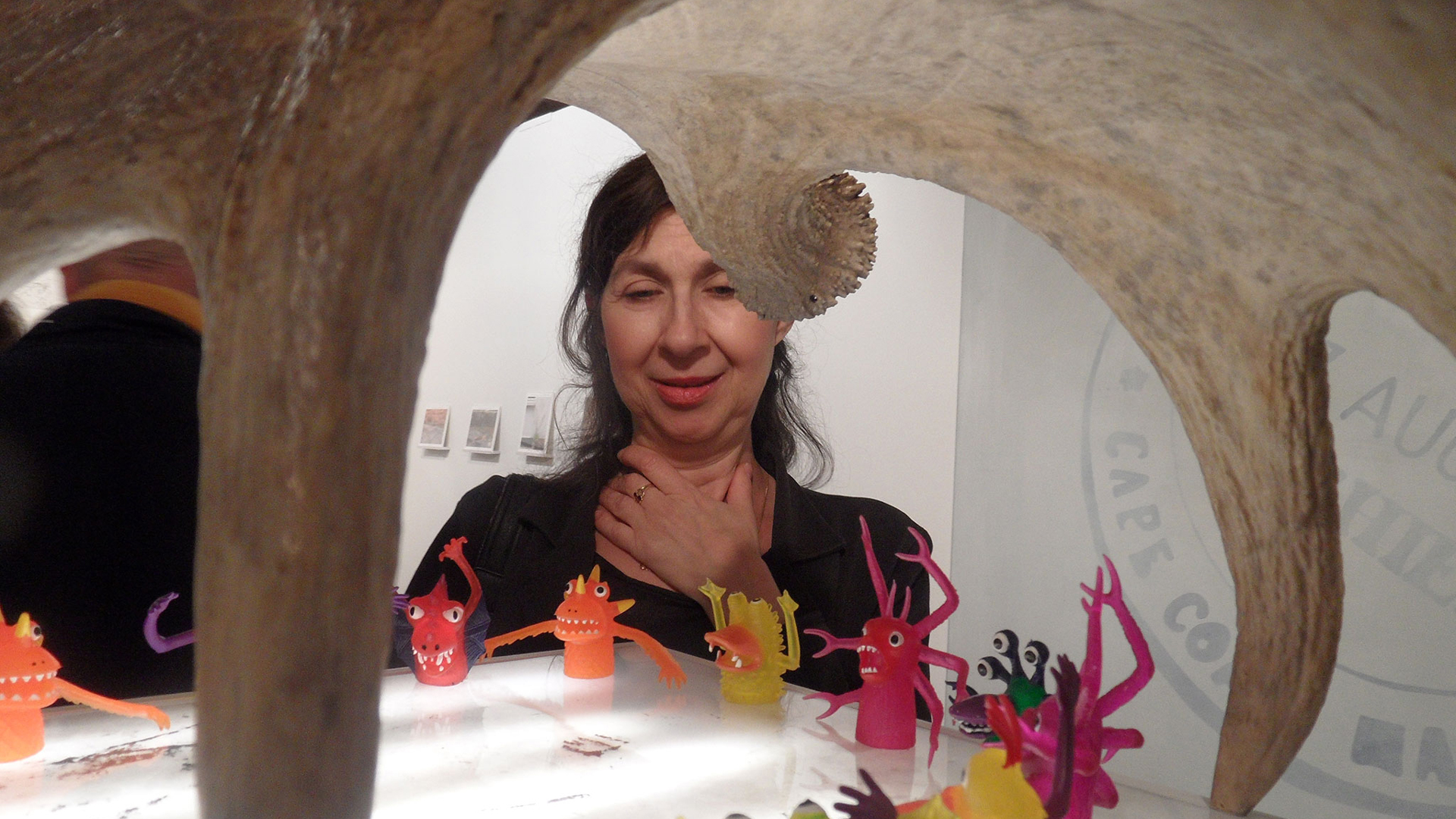Free Art-Republic EULENGASSE
Christoph Schütte
Well, I might get beat up in a minute or at least I get some disapproval, a look or something like »No, that’s not what I meant.« But alright, I have to start somewhere. I mean, before somebody somewhere starts something, it can’t kick off. And, in the beginning, the bible says, the earth was a desert and empty, and it could have been like that – maybe should have – like the Moon and Mars. Only, the creator had other plans. So, now we see land here, some ocean over there, sky and earth, plants, fishes, and so on, Adam, Eve, a little apple tree and the snake, and everything was fine, in the Garden of Eden.
Really? Well, it’s hard to tell, no one was there, none of us at least. But anyway, what I want to say is: The garden, the paradise implies that even before the fall of mankind an inside and an outside of a lattice fence and rubble masonry. Who ever visits the Städel Museum in Frankfurt and goes to the little Garden of Paradise can see it. Like today somehow in the world of the 21st century: Inside and outside. We just didn’t know anything about it. And, nevertheless, if our dear god had not been so inflexible with regards to human curiosity, thirst for knowledge and creativity, we would have remained just fine. We didn’t know anything about an outside anyway.
All in a nutshell: A person takes care of the territory only in the real world, in the vale of tears of the earthly existence. It is the room, Heidegger says in »Being and Time«, which constitutes the world. And maybe it is true, the room as enclosed and delimited. But who defines the room? And what for?
In Wikipedia we find: »A territory is a term for types of administrative division, usually an area that is under the jurisdiction of a state.« That’s it.
This means, the subject is always combined with the idea of authority and with the demarcation against the others, the enemy, the bad or just against the stranger, the neighbor, the Hun, the Mongol, the Barbarians. On the one hand, there is also another, an enlightened, an inclusive not exclusive version. A commitment, not a destiny, something which units not isolates: The republic. In the last 20 years it has changed, even in Europe and one might think about the fall of Yugoslavia. The units become smaller and they want to be marked. And apparently, the others »Huns, Mongols and Barbarians« are becoming more.
In this respect it seems that the topic of this exhibition in time in which people are leaving their homes – have to or want to in order to survive or find a better life – the topic seems to be late-breaking. Political. Crucial. It certainly forces one to take sides. But: What does this have to do with art? Initially not all too much. At least not necessarily. For there is a lack of form and the group of artists here know that.
So, back to the beginning. Not only the territory, my garden and national territory are bound to the world. The creative human invents himself after he is kicked out of Paradise. But the territory of art exists without a toll bar, if it is not Hosanna praising, kitsch or just a predication. And art is, given, we cut out the disavowals of the art scene, a room without authority. Sure, normally we put it in its own rooms, in museums, galleries and so on. And often it is the context which makes it visible as art. This also, with permission, an appropriation, an occupation of the territory of the real and the imagination.
Trespassing is generally welcomed and it does sort out the territory. And I believe this is what the topic here is about. So, not a two-world or more-world theory, but about something else, something beyond everyday business, daily news, human needs, flights, hunger, war and aggression, conquers, migration and the abyss.
What can that look like? – Let’s have a look at these positions. What can we see? Here photography, there painting, drawing, video, installation and sculpture. What do they have in common?
Let’s start with Heide Khatschaturian’s Höhle (Cave): We can see a self-sufficient troll-society, where everybody takes each other by the hand, just like in kinder garden. With the work of Helmut Werres we see abstraction, a little nervous looking drawings, paintings by Andrea Blumör, a sort of library by Harald Etzemüller and Sabine Zimmermann’s photos of weeds in the street. What else? Two wonderful, wondrous movies. In Vládmir Combre de Sena’s »Ehrenmänner« (Men of Honor) two duelists in front of a steady camera in the fields try to figure something out through a striptease poker and one by Marcelo Coutinhos, »Ô« from the year 2008. How can one bring these different things into one context? And why put such works together in an exhibition, which are obviously don’t fit? But what does fit: The concept of the artist-run space EULENGASSE. Because it was actually created in order to present a room, an idea. Naturally this room represents not exclusion, but what there is in common. So to say as the »Free art-republic of EULENGASSE«. It is, with permission, an artistic attitude, but without question, a decidedly political approach to the world: A crossing the borders. Or to use a big word: A utopia. A utopia in times of solely used and preferred pragmatism. This alone is already a statement. And, if according to Heidegger, the world is constituted by the room, then this is what all this is about in every single work: It is about the room and the world, and the image, we create of it and it is therefore about defending the territory of art. It happens with different means, of course, but for all artists the process is important. A far away horizon that presents the world to us: How it is, how it could be and how we picture it.
I’d like to introduce Vládmir’s »Duel« as an image of the defense of honor, and maybe also as a claim, which ridicules itself perhaps of it’s own territory. It doesn’t matter where the duelists stand in front of each other, in Hungary, Turkey, Greece, in Berlin or Frankfurt Bonames. The sound by Pierre Boulez »Structures pour 2 pianos« definitely plays a role. A drawing by Helmut Werres, who acquires and verifies the room since he is drawing watching out of the train’s window, sometimes for hours, like on the journey to Stockholm. And the landscape: Mountains, valleys, villages, train stations and cities, which passing by the train’s window. Sleepers, switches, suspensions, the tired hand, daylight and artificial lighting, feeling hungry or thirsty or a full bladder, in one word: The world, which is passing by, is drawing with him. In the core mimetic, but on the paradox leading into the absolute abstraction of the appropriation of the world. But first and foremost: A picture. A picture whose lines and lineatures of the room and its space, the journey itself is as with the passing of time is registered in the act of drawing.
Harald Etzemüller takes photos of different rooms, like a sketch-book, photos of landscapes, resorts for culture and recreation and memorials. He places a selection of reference books in the installation and this opens up a new room. In contrast, Heide Khatschaturian’s trolls do the opposite. Maybe they see, like in Plato’s Cave Allegory, nothing but shadows and take them for real. And they want to expand their room, while they are touching, thinking and watching to find the idea to do so.
And who knows, maybe that is what they are doing and we just have to believe in it a little harder. Like Marcelo Coutinho, his video »Ô« reminds us of the Surrealist’s movies, where reality, dream and nightmare are not so easy to differ from one another and maybe it is the same. What is going on? A man grinds a knife tirelessly almost until nothing remains, a woman dances in ecstasy or has an epileptic attack, and here and there first a donkey, than a cow or a horse are falling from the sky. »The limits of my language stand for the limits of my world«, says Wittgenstein. This has always been Coutinhos subject: Overstepping boundaries through artistic means is not only present in his dictionary of neologisms, it is also the topic of »Ô«. And it is, to say so, the issue of this exhibition.
The work of Andrea Blumör and Sabine Zimmermann look in essence conceptual and both work in series. They are inspired by remembrance, the past and its visualization (realization) maybe more than in the work of the other five artists. This is particularly true for the painting of Blumör, who uses very simple often trivial reference materials, shopping lists, receipts, sales slips, she might find them in a pocket or a drawer, official stamps, or a visa in her own passport. They always stand for a process, an event or a recollection; for an encounter with things and people. As a marker in a shared but fragmentary narrative.
It is a very long time consuming process in which she uses egg-tempora and various layers of oil glazes. She takes her reference material and recreates it onto a large support.
I would like to call Sabine Zimmermann’s sequel a narrative as well. A narrative which develops similarly to the painting of Blumör, but obviously in different medium and form. The title relates to a work by Ian Hamilton Finlay »Les Femmes de la Revolution«, which refers to Anselm Kiefer’s lead-beds with the same title. Do you need to know that? Well, as always in arts it doesn’t hurt. Because, instead of lead-like heaviness the observer meets dog violets, dandelion, a jewel weed, ivy, clover, a thistle and many more. And each of the weed which hold it’s ground in the gutter and the paving they adopt names of famous women: Marie-Antoinette or Charlotte Corday, Albertine Marat or Madame de Staël. And the narrative emerges as pure poetry by poets like Inger Christensen, Marlen Haushofer or Ingeborg Bachmann, artists like Maria Sibylla Merian and Louise Bourgeois, Eva Hesse or Charlotte Salomon. She was murdered in Auschwitz, but her gouache sequels »Life? Or Theater?« survived and was shown at the last documenta. With them also Simone Weil, Hannah Arendt, Alma Mahler or Hildegard von Bingen. Each one of them was a sparkle of hope in the dark universe. An idea and an occupied room, a thought which takes root in inhospitable surroundings, persistent and also holding ground. Once, in the world it cannot be dispersed anymore.
And it is true, whatever you may think about the pictures: The earth is an inhospitable place. And like long time ago a desert and empty. But any grass, each rib-wort or thistle is an act of resistance, a sign of hope of the occupation of a surrendered territory. And a beginning, time and time again and again. That’s all. And that’s what it’s all about.
(Translation: Andrea Blumör)
Freie Kunstrepublik EULENGASSE
von Christoph Schütte
Wahrscheinlich werde ich jetzt Prügel bekommen. Einen Tadel wenigstens, irritierte Blicke oder ein „Nein, so war das nicht gemeint.“ Aber das macht nichts. Man muss ja irgendwo anfangen.
Denn bevor irgendwo irgendjemand irgendetwas anfängt, kann es halt nicht losgehen. Und am Anfang, so steht es in der Bibel schon geschrieben, am Anfang war die Erde wüst und leer. Und das hätte sie auch bleiben können. Sollen vielleicht. Wie der Mond oder der Mars.
Allein, der Schöpfer hatte andere Pläne.
Also sehen wir hier Land, da Meer, den Himmel und die Erde, Pflanzen, Fische usw, Adam, Eva, ein Apfelbäumchen und die Schlange. Und alles war gut im Garten Eden.
Oder? Schwer zu sagen, von uns hier war ohnehin keiner dabei. Aber egal. Was ich sagen will: Der Garten, das Paradies impliziert schon vor dem Sündenfall ein innerhalb und außerhalb von Lattenzaun und Feldsteinmauern. Wer ins Städel geht und die Tafel des Paradiesgärtleins anschaut, kann es sehen.
Wie jetzt auch irgendwie in der Welt des 21. Jahrhunderts. Innen und Außen. Nur wussten wir halt davon nicht.
Und doch, hätte nicht der liebe Gott sich derart unflexibel gezeigt bezüglich menschlicher Neugier, Wissensdurst und Schöpferkraft, wir wären wohl geblieben. Wir kannten sowieso kein Außen.
Langer Rede kurzer Sinn: Der Mensch nimmt sich des Territoriums erst in der Welt an, im Jammertal des irdischen Daseins.
Es ist der Raum, sagt Heidegger etwa in „Sein und Zeit“, der die Welt konstituiert. Und vielleicht stimmt das auch. Der Raum aber als immer schon eingehegter, abgegrenzter. Doch wer definiert wie den Raum? Und zu welchem Zweck.
Auf Wikipedia steht es so: „Territorium, lat. Gebiet, bezeichnet einen von Grenzen eingefassten räumlichen Bereich, auf den ein Hoheitsanspruch erhoben wird.“ Punkt.
Das heißt, der Begriff ist stets mit der Idee von Herrschaft verbunden. Und mit Abgrenzung gegen den Anderen. Den Feind, den bösen oder auch nur fremden Nachbarn, die Hunnen, Mongolen und Barbaren.
Einerseits. Denn es gibt noch eine andere, eine aufgeklärte, eine inklusive statt exklusive Version. Ein Bekenntnis also, nicht Schicksal, etwas, das eint, nicht trennt. Das ist die Republik.
Das hat sich in den vergangenen 20 Jahren selbst in Europa gründlich verändert. Plötzlich, man denke nur an den Zerfall Jugoslawiens, werden die Einheiten wieder kleiner und entsprechend deutlich markiert. Und die Anderen – Hunnen, Mongolen und Barbaren – werden scheinbar immer mehr.
Insofern erscheint das Thema dieser Ausstellung in Zeiten, in denen Millionen Menschen um des Über- oder Besser-Lebens weg müssen oder wollen von dort, wo sie sind, brandaktuell. Politisch. Entschieden. Partei ergreifend.
Nur: Was hat das mit der Kunst zu tun? Zunächst einmal nicht allzu viel. Nicht zwangsläufig jedenfalls. Dafür fehlt es entschieden an Form. Und die hier versammelten Künstler wissen das natürlich auch.
Also noch mal von vorn. Denn nicht nur das Territorium, mein Garten und das Staatsgebiet sind an die Welt gebunden, auch der schöpferische Mensch erfindet sich erst bei seinem Rauswurf aus dem Paradies.
Nur kommt das Territorium der Kunst, sofern sie nicht in Hosianna, Kitsch oder Behauptung sich erschöpft, grundsätzlich ohne Schlagbaum aus.
Und ist, sehen wir einmal über die Verwerfungen des Betriebs großzügig hinweg, so etwas wie herrschaftsfreier Raum.
Klar, am liebsten stecken wir sie in eigene Räume. In Museen, Galerien usw.. Und nicht selten ist es der Kontext, der sie als Kunst erst sichtbar werden lässt. Auch das eine Aneignung, wenn man so will. Eine Eroberung des Terrains, des gegebenen oder auch nur vorgestellten Raums.
Jede Grenzüberschreitung aber ist grundsätzlich zu begrüßen. Sondiert sie das Territorium doch immer wieder neu.
Und ich denke, darum geht es hier. Auch. Nicht um eine Zwei- oder mehr Welten-Theorie. Aber doch um etwas anderes jenseits tagespolitischer Ereignisse, menschlicher Nöte, Fluchten, Hunger, Krieg und Aggressionen, neben Eroberungen, Wanderungen und Abgründen.
Wie könnte das aussehen?
Werfen wir einen ersten Blick auf die hier versammelten Positionen. Was sehen wir da? Hier Fotografie, dort Malerei, Zeichnung, Video, Installation und Skulptur. Was haben die miteinander zu tun?
In Heide Khatschaturians „Höhle“ etwa sehen wir – Achtung Kalauer – eine buchstäblich trollige, auf sich selbst zurückgeworfene Gesellschaft, die sich wie im Kindergarten an den Händen fasst. Von Helmut Werres sehen wir abstrakte, ein wenig nervös anmutende Zeichnungen, Malerei von Andrea Blumör, eine Art Bibliothek von Harald Etzemüller, und Sabine Zimmermann fotografiert Unkraut am Wegesrand. Gartenflüchter, wie sie sagt – woran ich aus eigener gärtnerischer Erfahrung meine Zweifel habe: Denn eigentlich sind sie immer schon da.
Was noch? Zwei wunderbare, wundersame Filme. Die zwei Duellanten in Vládmir Combre de Senas „Ehrenmänner“, die vor fest installierter Kamera auf offenem Feld eine Art Strippoker ausknobeln, sowie Marcelo Coutinhos „Ô“ aus dem Jahr 2008.
Wie soll man das auf einen Nenner bringen? Und warum bringt die Ausstellung zusammen, was doch offensichtlich nicht zusammen gehört?
Was natürlich unbedingt zusammen gehört. Und das nicht nur, aber durchaus auch, weil diese Ausstellung entstanden ist, um einen Raum, eine Idee, wenn man so will: das Konzept Ausstellungsraum Eulengasse vorzustellen.
Nur dass der Raum hier naturgemäß nicht Ausgrenzung, sondern Gemeinsames repräsentiert. Als »Freie Kunstrepublik EULENGASSE« sozusagen. Wenn man so will eine künstlerische, aber als solche selbstredend auch eine entschieden politische Haltung gegenüber der Welt. Eine Überschreitung der Grenzen.
Oder, um ein großes Wort zu bemühen: Eine Utopie. Eine Utopie in Zeiten eines scheinbar allein selig machenden Pragmatismus. Schon das darf man ein Statement nennen.
Und wenn nach Heidegger der Raum die Welt konstituiert, dann geht es hier in jeder einzelnen der Positionen genau darum: um den Raum und um die Welt. Und das Bild, das wir uns davon machen. Und damit um eine Verteidigung des Territoriums der Kunst.
Das geschieht mit unterschiedlichen Mitteln, ganz klar. Hier wie dort aber, denke ich, ist der Prozess entscheidend. Vor jenem fernen Horizont, der uns die Welt vorstellt. Wie sie ist, wie sie sein könnte, wir sie uns ausmalen.
Als Bild, als das ich Vládmirs Duell einmal verstehen will für die Verteidigung der Ehre, einer sich selbst lächerlich machenden Behauptung des eigenen Territoriums vielleicht auch.
Ob die beiden Ehrenmänner sich nun in Ungarn, der Türkei, Griechenland, in Berlin oder in Frankfurt Bonames gegenüber stehen, spielt dabei keine Rolle. Dass Pierre Boulez’ „Structures pour 2 pianos“ die Tonspur vorstellen dagegen wohl.
Ein Bild auch bei Helmut Werres, der sich den Raum aneignet und beglaubigt, indem er aus dem Fenster schauend zeichnet. Manchmal stundenlang, wie auf der Fahrt nach Stockholm.
Und die Landschaft, Berge, Täler, Dörfer, Bahnhöfe und Städte, die vor dem Zugfenster vorüberziehen, Schwellen, Weichen, Federung, die müde Hand, Tageslicht und Nachtbeleuchtung, Hunger, Durst oder die volle Blase, in einem Wort:
die Welt, wie sie vor seinem Auge vorüberzieht, all das zeichnet mit. Eine im Kern mimetische, paradoxerweise aber in die völlige Abstraktion führende Aneignung von Welt.
Doch vor allem anderen: Ein Bild. Ein Bild, dessen Linien und Lineaturen Raum und Raumerschließung, die Reise selbst wie das Vergehen der Zeit zeichnend eingeschrieben sind.
Und während Harald Etzemüller unterschiedliche Räume fotografiert wie für ein Skizzenbuch – Landschafts-, Kultur- oder Erholungsräume, Schreckens- und Gedenkorte, Siedlungsräume und dergleichen – und ihnen, vor allem aber dem Besucher, eine Art Handapparat zum Thema zur Seite stellt, um neue Räume aufzumachen, scheint es, als vollzögen Heide Khatschaturians Trolle die umgekehrte Bewegung.
Und sähen, statt sich Raum um Raum tastend, denkend, schauend zu erschließen und die Idee des Raumes solcherart auszudehnen und zu erweitern, gerade wie in Platons Höhlengleichnis nichts als Schatten, die sie für das eigentliche nehmen.
Und wer weiß, vielleicht sind sie das ja manchmal auch. Und man muss nur etwas fester, etwas unbedingter daran glauben. Wie Marcelo Coutinho, dessen Video „Ô“ an die Filme der Surrealisten denken lässt, wo Realität und Traum und Albtraum nicht so leicht zu unterscheiden sind. Oder vielleicht sogar dasselbe.
Denn was geht hier vor? Ein Mann schleift unermüdlich ein Messer, bis fast nichts mehr davon übrig ist, eine Frau tanzt sich in Ekstase oder erleidet einen epileptischen Anfall, und ab und an fällt erst ein Esel, dann eine Kuh oder ein Pferd vom Himmel.
„Die Grenzen meiner Sprache bedeuten die Grenzen meiner Welt“, sagt Wittgenstein. Das ist Coutinhos Thema seit jeher: Diese Grenzen mit künstlerischen Mitteln zu überschreiten, liegt nicht nur seiner Idee eines Wörterbuchs voller Neologismen zugrunde. Es ist auch das Thema von „Ô“. Und, wenn man so will, das Thema dieser Ausstellung.
Wesentlich konzeptuell erscheinen die Beiträge der durchweg seriell arbeitenden Andrea Blumör und von Sabine Zimmermann charakterisiert. Und vielleicht stärker noch als die Arbeiten der anderen fünf Künstler von der Erinnerung, von Vergangenem und seiner Vergegenwärtigung inspiriert.
Das gilt sicher für die Malerei Blumörs, für die der Künstlerin stets äußerst schlichte, ja banale Motive als Vorlage dienen. Das können Einkaufslisten, Quittungen oder Kassenzettel sein, die sie in der Hose oder irgendeiner Schublade findet, Stempel eines Amts und einer Wechselstube oder der Einreisevermerk im eigenen Pass.
Immer aber stehen sie für einen Vorgang, ein Ereignis, eine Erinnerung. Für Begegnungen mit Dingen und Menschen. Eine Wegmarkierung in einer nur fragmentarisch überlieferten Erzählung.
Und während sie die Vorlagen aufbläst und in Eitempera und aufwendiger Lasurtechnik in wochen- und monatelanger Arbeit auf Leinwand umsetzt, ist es der Prozess, der sie, wo nicht gar generiert, im Werden des Bildes doch wenigstens beglaubigt.
Eine Erzählung möchte ich auch die Serie von Sabine Zimmermann nennen. Eine Erzählung aber, die, wiewohl sie sich hinsichtlich des Mediums und der Form von der Malerei Blumörs deutlich unterscheidet, ähnlich assoziativ sich entwickelt.
Das fängt schon mit dem Titel an, der sich erklärtermaßen auf „Les Femmes de la Révolution“ von Ian Hamilton Finlay bezieht, die wiederum auf Anselm Kiefers bleierne Betten mit dem gleichen Titel Bezug nehmen.
Muss man das wissen? Nun, wie immer in der Kunst, es schadet nicht. Denn statt bleierner Schwere begegnen dem Betrachter Hundsveilchen und Löwenzahn, ein Springkraut, Efeu, Klee und eine Distel und noch so allerlei.
Und statt Marie-Antoinette oder Charlotte Corday, Albertine Marat oder Madame de Staël nimmt ein jedes der im Rinnstein, aus dem Straßenpflaster sprießenden oder in Mauerfugen sich behauptenden Unkräuter den Namen großer Frauen an.
Und die Erzählung entpuppt sich als reine Poesie. Von Dichterinnen wie Inger Christensen, Marlen Haushofer oder Ingeborg Bachmann, Künstlerinnen wie Maria Sibylla Merian oder Louise Bourgeois, Eva Hesse oder Charlotte Salomon. Sie wurde in Auschwitz ermordet. Ihre Gouachen-Folge „Leben? Oder Theater?“ hat überlebt. Und hatte auf der letzten Documenta einen bewegenden Auftritt.
Dazu Simone Weil und Hannah Arendt, Alma Mahler oder Hildegard von Bingen. Jede für sich ein Fünkchen Hoffnung im dunklen Universum. Eine Idee. Und die Besetzung eines Raumes. Ein hartnäckig sich behauptender, in unwirtlicher Umgebung Wurzeln schlagender Gedanke, der, einmal in der Welt, sich nicht vertreiben lässt.
Denn es stimmt ja, mag man vor diesen Bildern denken: Die Erde ist ein unwirtlicher Ort. Und wie vor aller Zeit vor allem wüst und leer. Jedes Gras aber, jeder Spitzwegerich und jede Distel ist ein Akt des Widerstands. Ein Zeichen der Hoffnung. Die Besetzung eines aufgegebenen Territoriums. Und ein Anfang, Mal für Mal. Das ist alles. Und die ganze Kunst.
A exposição »Territorium« foi apresentada na primavera de 2015 na feira Supermarket Independent Art Fair Stockholm e no outono de 2015 na Galeria EULENGASSE em Frankfurt am Main e 2016 na Gallery Axel Obiger, Berlin.
TERRITORIUM
»The living spaces a human is living in, moves in and orientates in is for others essentially invisible.«
(Franz Xaver Baier)
From our standpoint, the point where we stand, and from where we look far, we can realize: we can see the world. Some people are in the situation to judge the things they see and if they do so they realize that they don´t lack anything. Others like to see further. They see all the things which are underneath the shallowness of life. It is hard for them not to look around the corner. Living space.
In some places we walk with experience. Maybe in the city and the neighborhood in which we live and deal with our day-to-day. Some people travel through the whole world in a very short time. It is not only the space which determines our lives, we also determine the space – Living space: Territory.
Through our existence we create living spaces; we move through them and we flourish. We make decisions about how big our living spaces are through the meaning we bring to pieces and the time we use for them. We give them order and chaos and design them always new. The more living spaces we occupy, the more the world becomes familiar.
When we have more and more incidents in life and have the chance for more interpretations we know more about our space and we learn more about the world. We see people how they move through our space. But we cannot see how they arrange their lives, what is familiar to them and what stays unknown, what is meaningful and what isn´t. The territory is invisible. Art lets us feel the territory and makes it seem to be visible.
Curators
Andrea Blumör and Vládmir Combre de Sena
. 16 – 19 April 2015, SUPERMARKET Independent Art Fair Stockholm
. 26 November – 20 December 2015, Ausstellungsraum EULENGASSE Frankfurt/ BOK Offenbach am Main
. 06 – 27 Februar 2016, Gallery Axel Obiger, Berlin
with: Andrea Blumör, Vládmir Combre de Sena, Marcelo Coutinho, Harald Etzemüller, Heide Khatschaturian, Helmut Werres, Sabine Zimmermann.
